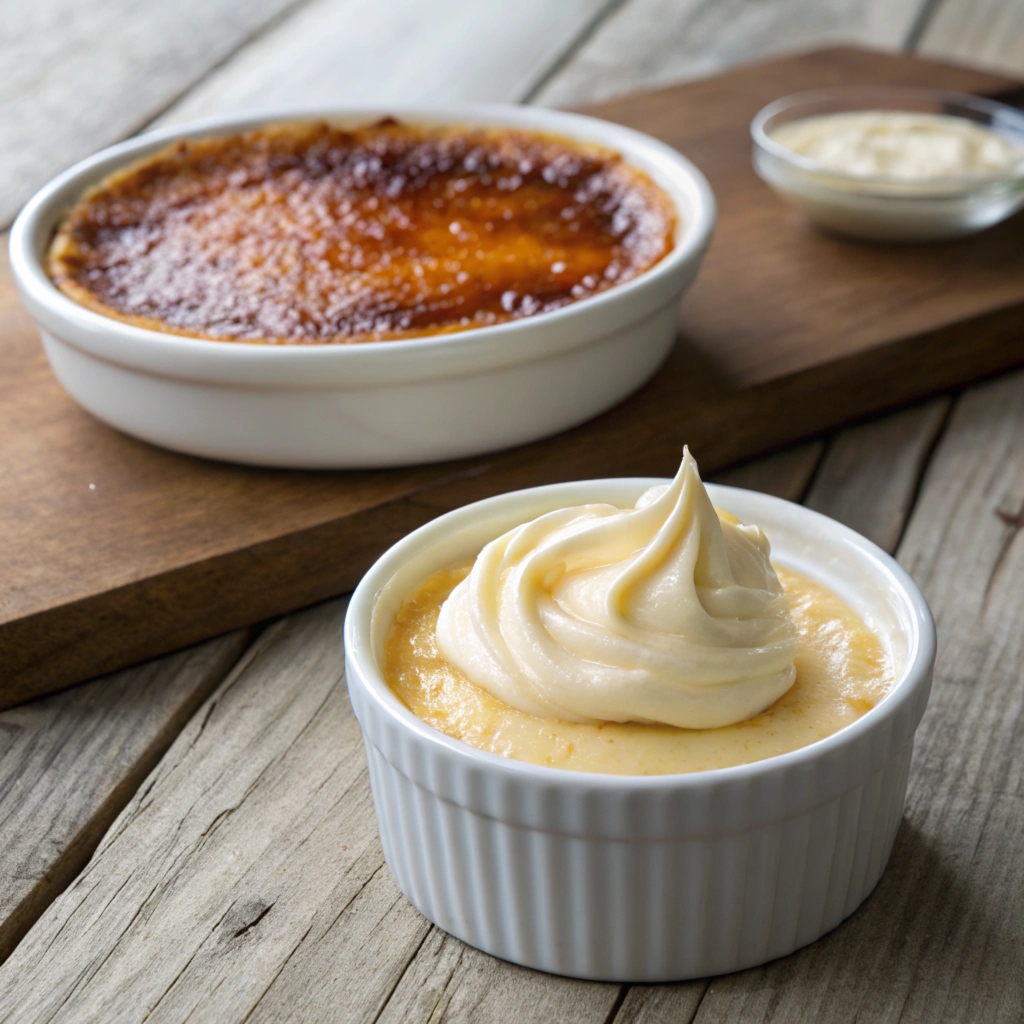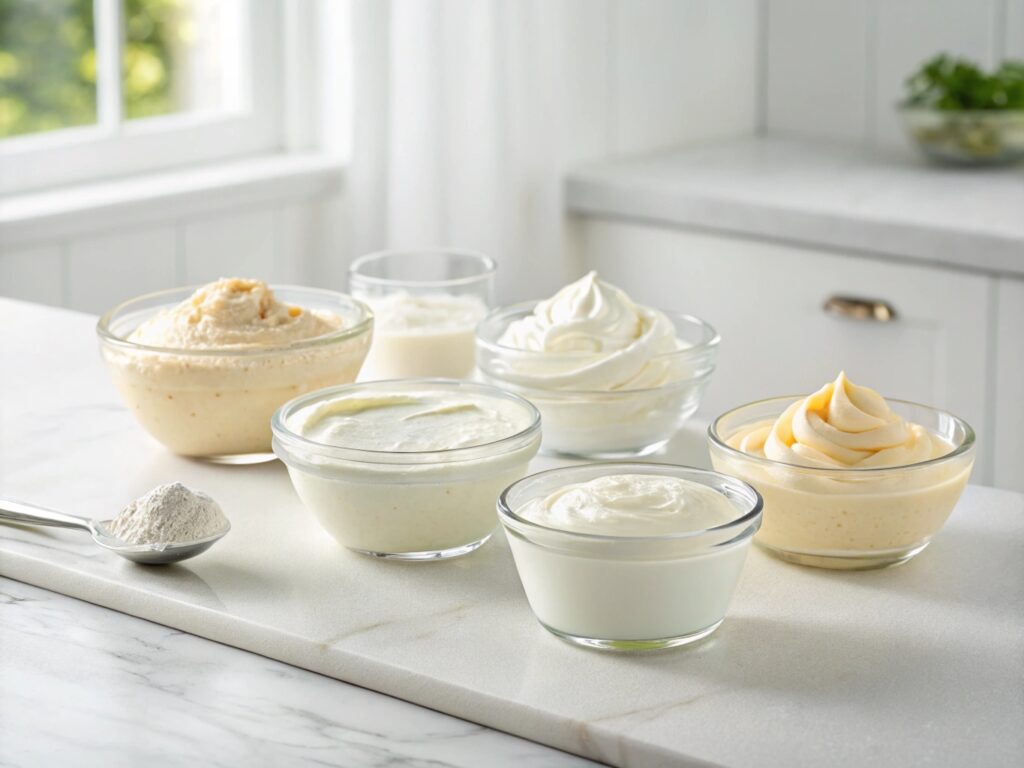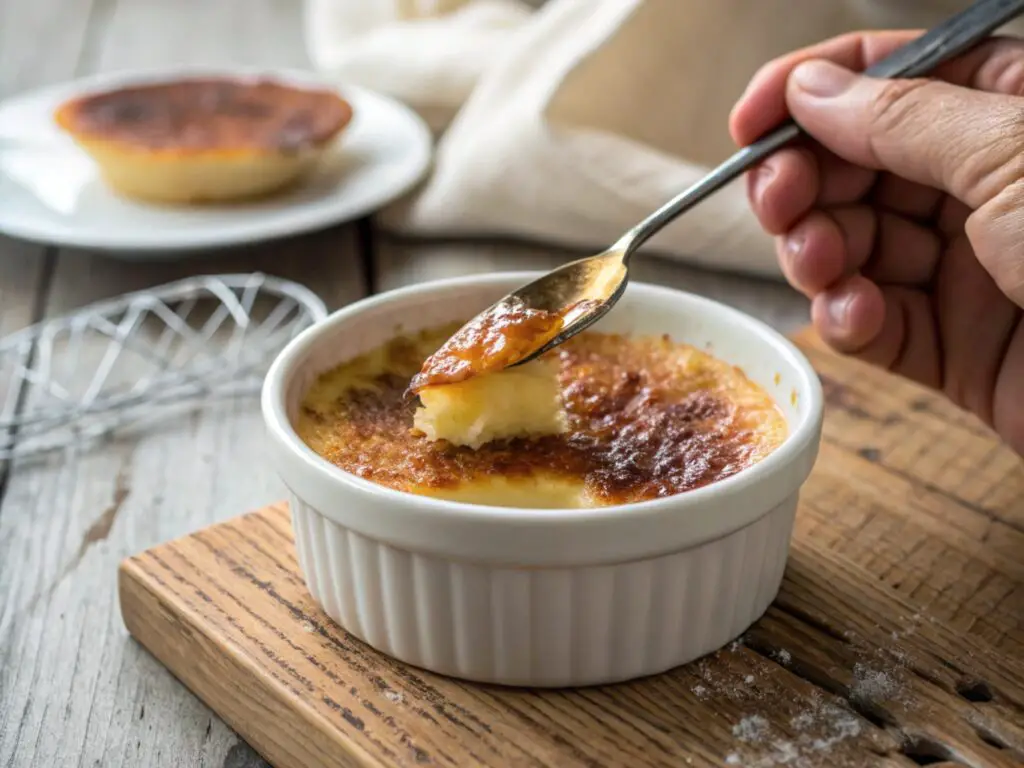Crème brûlée is one of the most iconic and elegant desserts in the world of culinary arts. Its smooth, velvety custard base topped with a perfectly caramelized sugar crust creates a balance of textures and flavors that few desserts can match. Often served at upscale restaurants and fine dining events, crème brûlée has become a symbol of sophistication and indulgence. When making crème brûlée, one crucial decision can make all the difference: what type of cream is best for crème brûlée? This guide will help you choose the perfect cream to create a rich, silky custard every time.
But what makes a crème brûlée truly exceptional? While many factors contribute to its success — such as the method of cooking and the use of a kitchen torch to achieve that signature caramelized top — the type of cream used plays a critical role. The cream directly affects the texture, richness, and overall flavor of the dessert. Use the wrong cream, and you might end up with a grainy, watery, or overly dense custard. Use the right cream, and you’ll achieve that silky smooth, melt-in-your-mouth experience that makes crème brûlée so irresistible.

Table of contents
What is Crème Brûlée?
Crème brûlée, which translates to “burnt cream” in French, is a timeless dessert known for its luxurious taste and texture. It consists of a rich custard base topped with a layer of hardened, caramelized sugar. While its name might sound fancy, crème brûlée is actually made with just a few simple ingredients: cream, egg yolks, sugar, and vanilla. Despite its simplicity, achieving the perfect balance of creaminess and crunch requires precision and attention to detail.
The Origins of Crème Brûlée
The history of crème brûlée can be traced back to France, where it first appeared in cookbooks during the late 17th century. Some food historians believe that similar custard desserts existed in Spain (known as “Crema Catalana”) and England (known as “Trinity Burnt Cream”). However, it was the French version that gained global recognition as the gold standard for this dessert. Its preparation method, specifically the caramelization of sugar using an open flame or kitchen torch, has become a hallmark of French culinary tradition.
Why is Crème Brûlée So Popular?
Crème brûlée’s enduring popularity lies in its unique combination of textures and flavors. The moment you crack the caramelized sugar crust with a spoon, you’re met with a silky, smooth custard that melts in your mouth. The contrast between the crunchy top and the creamy base is a sensory experience that leaves a lasting impression. This dessert is also versatile — it can be flavored with vanilla, chocolate, coffee, or even exotic ingredients like lavender or citrus zest.
The Role of Cream in Crème Brûlée
At the heart of any good crème brûlée is the cream. Cream is responsible for the custard’s rich, velvety texture. When combined with egg yolks and sugar, it forms a smooth, thick mixture that sets perfectly during the baking process. The type of cream used affects the dessert’s texture, density, and mouthfeel. A higher fat content cream, like heavy cream or double cream, produces a richer, creamier texture, while lower-fat creams can result in a more watery or less indulgent experience.
Now that you understand What type of cream is best for crème brûlée? is and why cream is such an essential ingredient, it’s time to explore What type of cream is best for crème brûlée?. Should you use heavy cream, double cream, whipping cream, or something else? Keep reading to find out which cream will give you that silky-smooth texture and unforgettable flavor.
Why Choosing the Right Type of Cream is Important for Crème Brûlée
Cream is the heart of crème brûlée, influencing its taste, texture, and mouthfeel. The type of cream you choose can make or break the dessert’s quality. Here’s why it matters:
1. Taste
The cream’s fat content directly affects the flavor. Heavy cream (36-40% fat) delivers a rich, buttery taste that enhances the sweetness of the custard. Low-fat options like half-and-half or milk result in a thinner, less indulgent flavor. For a true restaurant-quality experience, heavy cream is essential.
2. Texture
Crème brûlée’s signature silky texture depends on cream with a high-fat content. Heavy cream and double cream create a smooth, velvety consistency. Lighter creams or milk have more water, leading to a looser, jiggly custard. For a firm, creamy custard that holds its shape, opt for heavy cream.
3. Mouthfeel
The rich, luxurious mouthfeel of crème brûlée comes from the fat in the cream. Heavy cream provides a silky, buttery texture that melts on the tongue. Lighter creams lack this richness, making the custard feel watery or less satisfying.
How Cream Affects the Dessert Experience
Using heavy cream guarantees a silky-smooth, stable custard that melts in your mouth. While half-and-half or milk may seem like healthier options, they compromise both texture and flavor. For a true five-star experience, heavy cream is non-negotiable.
Types of Cream Used for Crème Brûlée
Not all creams are suitable for crème brûlée. The fat content and consistency of the cream directly affect the texture, flavor, and stability of the custard. Here’s a look at the most common options:
H3: Heavy Cream (The Best Choice)
When it comes to making crème brûlée, heavy cream is the gold standard. It’s used in most traditional recipes due to its ideal balance of fat, texture, and availability.
1. What is Heavy Cream?
Heavy cream, or heavy whipping cream, contains 36-40% milk fat, much higher than milk, half-and-half, or whipping cream. This high-fat content creates a rich, creamy custard that holds its shape perfectly after baking.
2. Why is Heavy Cream the Best Choice?
- Rich Flavor: Heavy cream provides a buttery, full-bodied taste that balances the sweetness of the custard.
- Silky Texture: The high-fat content produces a velvety, smooth consistency that melts in your mouth.
- Stable Structure: Heavy cream’s high-fat content prevents curdling and maintains the custard’s shape during baking. Lower-fat options like milk or half-and-half increase the risk of separation.
3. How Fat Content Affects Texture
The 36-40% fat in heavy cream creates a stable, smooth emulsion when combined with egg yolks and sugar. During baking, water in the cream slowly evaporates, allowing the custard to set perfectly. Lower-fat creams contain more water, leading to a looser, jiggly consistency.
If you want a silky, smooth crème brûlée that holds its shape, heavy cream is your best choice.s water, it creates a denser, richer texture. If you use a lower-fat cream, the higher water content can lead to a looser, jiggly custard that struggles to set properly.
4. How Does Heavy Cream Compare to Other Creams?
| Type of Cream | Fat Content | Texture in Crème Brûlée | Flavor | Best Choice? |
|---|---|---|---|---|
| Heavy Cream | 36-40% | Rich, smooth, silky | Full, buttery | ✅ Yes, the best choice |
| Double Cream | 48-50% | Extremely thick, dense | Extra rich | Good, but thicker than needed |
| Whipping Cream | 30-35% | Softer, lighter | Mild, less rich | Not ideal — texture is softer |
| Half-and-Half | 10-12% | Watery, loose | Weak, watery | ❌ No, avoid it |
| Milk | 0-4% | Too watery, won’t set | Weak, bland | ❌ No, avoid it |
As the table shows, heavy cream strikes the perfect balance between fat content, flavor, and texture. While double cream is richer, it can sometimes be too thick, leading to a denser custard that may feel too heavy. Whipping cream, on the other hand, has less fat, making the custard less creamy and less stable. Half-and-half and milk are simply too low in fat to create the ideal texture.
5. Possible Drawbacks of Heavy Cream
While heavy cream is the best option, it’s not without its drawbacks:
- High Calorie Count: Heavy cream has a higher fat content, which means more calories. For those looking for a “lighter” crème brûlée, this could be a concern.
- Availability and Cost: In some regions, heavy cream may be more expensive or less available than other cream options. However, since it’s a key ingredient in many recipes, it’s usually easy to find in most grocery stores.
6. Final Verdict on Heavy Cream
If you’re looking for a foolproof way to make the perfect crème brûlée, heavy cream is the best choice. It creates a rich flavor, a smooth texture, and a custard that holds its shape perfectly. While some may try to use lower-fat alternatives, these substitutions often lead to disappointing results. If you want that classic French experience with a silky, indulgent custard under a crispy caramelized sugar top, heavy cream is the way to go.

Step-by-Step Instructions
Step-by-Step Instructions
Making crème brûlée at home is simpler than it looks. Follow these steps for a silky custard and crispy caramelized top.
Step 1: Gather Ingredients & Tools
Ingredients:
- 2 cups heavy cream
- 5 egg yolks
- 1/2 cup sugar (plus extra for caramelizing)
- 1 tsp vanilla extract
Tools:
Whisk, bowls, strainer, ramekins, baking dish, kitchen torch, kettle (for water bath)
Step 2: Make the Custard
- Heat the Cream: Warm heavy cream until bubbles form at the edges.
- Whisk Yolks & Sugar: Mix yolks with sugar until pale yellow.
- Temper the Eggs: Slowly add warm cream to the yolk mixture, whisking constantly.
- Strain: Pour custard through a fine strainer to remove lumps.
Step. 3: Bake the Custard
- Fill Ramekins: Pour custard into ramekins, filling them ¾ full.
- Water Bath: Place ramekins in a baking dish with hot water halfway up the sides.
- Bake: Bake at 325°F (160°C) for 30-40 minutes until set but jiggly.
- Chill: Cool and refrigerate for at least 2 hours.
Step. 4: Caramelize the Sugar
- Add Sugar: Sprinkle a thin sugar layer on top.
- Torch It: Use a kitchen torch to caramelize until golden brown.
Step 5: Serve & Enjoy
Once the caramel crust hardens, serve immediately and enjoy the satisfying “crack” as you break into the creamy custard.
Pro Tips for Perfect Crème Brûlée
- Use Heavy Cream Only: Avoid milk or half-and-half for a richer, smoother texture.
- Temper the Eggs: Add warm cream slowly while whisking to prevent curdling.
- Use a Water Bath: It ensures even cooking and prevents cracks.
- Strain the Mixture: Removes lumps for a smooth, silky custard.
- Caramelize with Care: Torch sugar evenly for a golden brown crust — avoid burning.
Common Mistakes When Using Cream for Crème Brûlée
1. Using Low-Fat Cream
Mistake: Using milk or half-and-half.
Problem: Watery, unstable custard.
Solution: Use heavy cream (36-40% fat) for a rich, smooth texture.
2. Overheating the Cream
Mistake: Boiling cream instead of gently heating it.
Problem: Curdled custard.
Solution: Heat cream until bubbles form at the edges, but do not boil.
3. Skipping the Water Bath
Mistake: Baking custards without a water bath.
Problem: Uneven cooking, cracked tops.
Solution: Place ramekins in a water bath to ensure even, gentle heat.
4. Overcooking the Custard
Mistake: Baking for too long.
Problem: Grainy, “eggy” custard.
Solution: Bake at 325°F (160°C) and remove once the center has a slight jiggle.
5. Burning the Sugar
Mistake: Over-caramelizing the sugar.
Problem: Bitter, burnt flavor.
Solution: Caramelize slowly with a torch, stopping at golden brown.
FAQs
Here are some of the most commonly asked questions about What type of cream is best for crème brûlée? to use. These answers will help you achieve the perfect texture, flavor, and presentation for this classic dessert.
What is the secret to crème brûlée?
The secret to making perfect crème brûlée lies in a few key techniques:
- Use Heavy Cream: The high fat content creates a rich, creamy custard.
- Temper the Eggs Properly: Slowly add warm cream to the egg yolks while whisking continuously to avoid curdling.
- Use a Water Bath (Bain-Marie): Placing the ramekins in a water bath ensures even, gentle cooking and prevents the custard from cracking or curdling.
- Don’t Overbake: Bake until the custard is set but still has a slight jiggle in the center. Overbaking results in a grainy texture.
- Caramelize with a Torch: Use a kitchen torch to caramelize the sugar evenly. Move it in circles to avoid burning any one spot.
By following these steps, you can achieve a silky-smooth custard topped with the perfect caramelized crust every time.
H3: What is a substitute for heavy cream in crème brûlée?
If you don’t have heavy cream on hand, here are some possible substitutes:
- Double Cream: Similar to heavy cream but with even more fat (about 48-50%). It will create an even richer custard.
- Whipping Cream: With 30-35% fat, it can be used as a substitute, but the custard will be slightly less rich.
- Coconut Cream: A dairy-free option with a creamy consistency similar to heavy cream. However, it will give the crème brûlée a distinct coconut flavor.
- Cashew Cream: Another vegan alternative, but it lacks the same richness as heavy cream.
Avoid using half-and-half or milk, as they contain too much water, leading to a thinner, less stable custard.
More Ideas
If you’re looking to master crème brûlée or expand your dessert skills, here are some inspiring ideas and related topics. These internal links offer helpful guides, recipes, and insights for creating custard-based desserts like crème brûlée.
1. Master the Secret to Perfect Crème Brûlée
Achieving a silky custard and crispy sugar top takes skill. Learn how to temper eggs, use a water bath, and caramelize sugar perfectly.
➡️ Secret to Perfect Crème Brûlée
2. Crème Brûlée vs. Custard – What’s the Difference?
Crème brûlée and custard may seem similar, but key differences exist in texture, flavor, and preparation.
➡️ Difference Between Crème Brûlée and Custard
3. What is Crème Brûlée Mostly Made Of?
Curious about the essential ingredients of crème brûlée? Learn about the role of cream, eggs, and sugar in this classic dessert.
➡️ What is Crème Brûlée Mostly Made Of?
4. Try a Unique Twist: Crab Brûlée
For a savory spin, try Crab Brûlée, a creative version that blends custard with rich crab flavor.
➡️ Crab Brûlée Recipe
5. Tips for Baking with Almond Flour
If you love experimenting with desserts, learn how to bake with almond flour. It creates a nutty, moist base that pairs well with custards.
➡️ Baking with Almond Flour
6. Get Tips for Super Moist Cakes
Love creamy custard? Learn how to achieve soft, moist cakes with a melt-in-your-mouth texture.
➡️ Secret to Super Moist Cake
7. Double Up the Flavor with Almond Cakes
Pair your crème brûlée with a rich, nutty almond cake for a perfect dessert combination.
➡️ Almond Nut Cake Recipe
8. Discover the Role of Cream in Custard-Based Desserts
Explore the role of cream in custards, from crème brûlée to savory custards. Learn why heavy cream is essential for rich, creamy textures.
➡️ Difference Between Crème Brûlée and Custard
9. Alternative Creams for Crème Brûlée
Don’t have heavy cream? Learn about substitutes like coconut cream, double cream, and other non-dairy options.
➡️ What is Crème Brûlée Mostly Made Of?
10. Explore Unique Custard Variations
If you enjoy crème brûlée, you’ll love exploring other custard-based desserts like panna cotta and Catalan cream. For a savory option, try Crab Brûlée.
➡️ Crab Brûlée Recipe
11. Understand Marzipan vs. Almond Paste
For desserts with almond flavor, know the difference between marzipan and almond paste.
➡️ Difference Between Marzipan and Almond Paste
hese ideas offer endless inspiration for perfecting your crème brûlée and exploring new culinary techniques. Click the links to learn more and master your dessert-making skills!

Conclusion
What type of cream is best for crème brûlée? is a timeless dessert known for its silky custard and crispy caramelized top. The secret to perfection lies in choosing the right cream, with heavy cream being the top choice. Its high-fat content creates a rich, smooth, and stable custard that sets perfectly. Alternatives like double cream or whipping cream can work, but they don’t offer the same luxurious texture. Avoid using half-and-half or milk, as they produce watery, unstable results.
Beyond the cream, success depends on key techniques like tempering the eggs, using a water bath, and properly caramelizing the sugar crust. By following these steps, you can achieve a restaurant-quality crème brûlée at home.
Now that you know what type of cream is best for crème brûlée, it’s time to put your knowledge into practice. With heavy cream, patience, and the right technique, you’ll achieve the perfect silky custard and crispy caramelized top every time.
